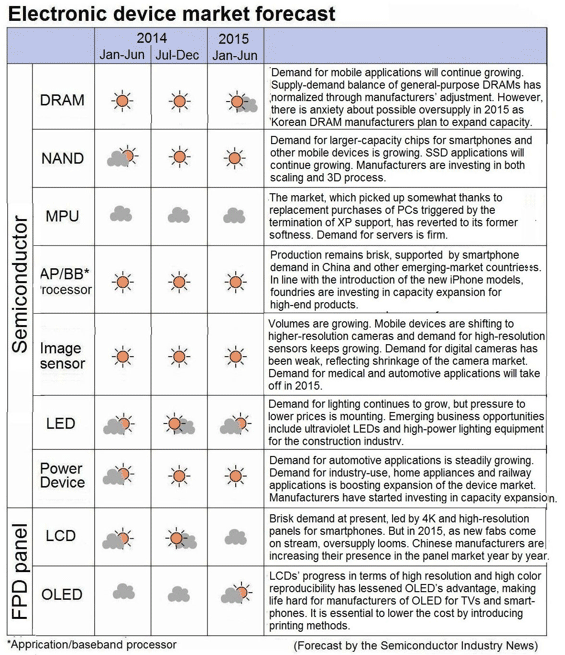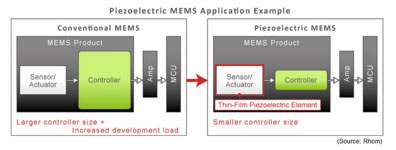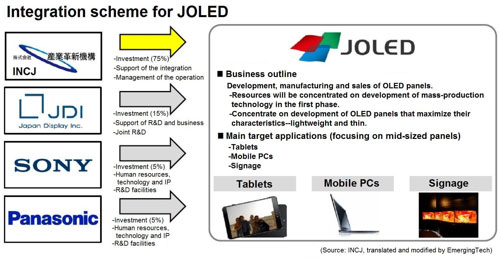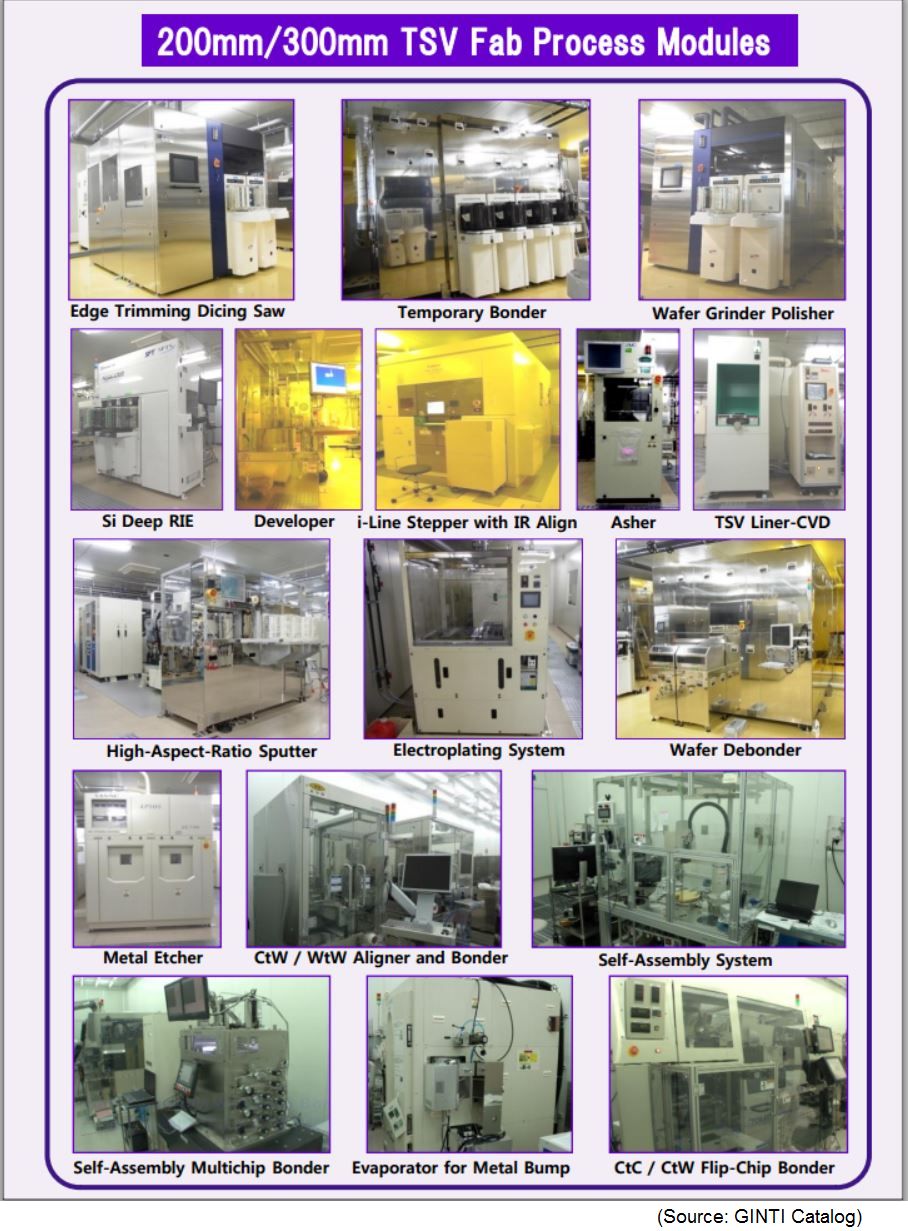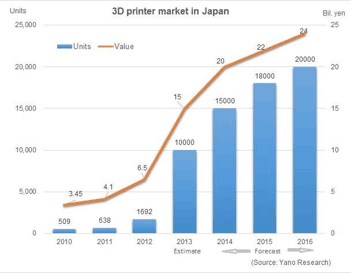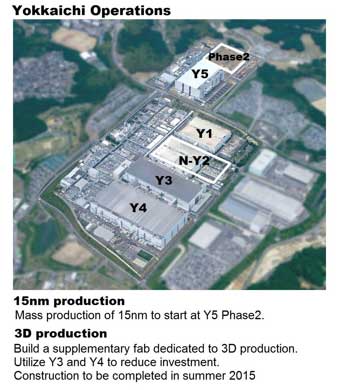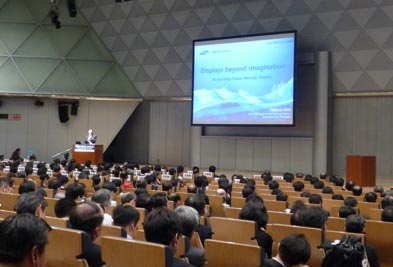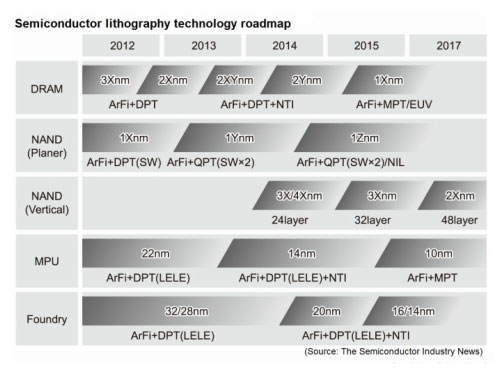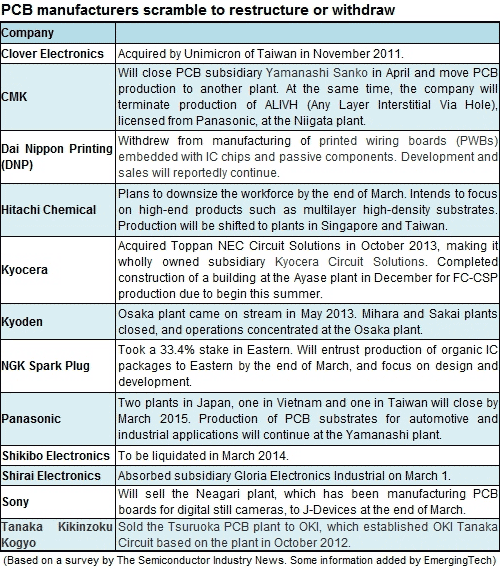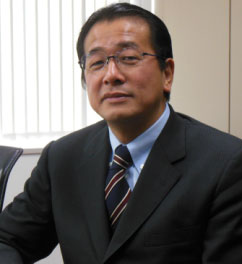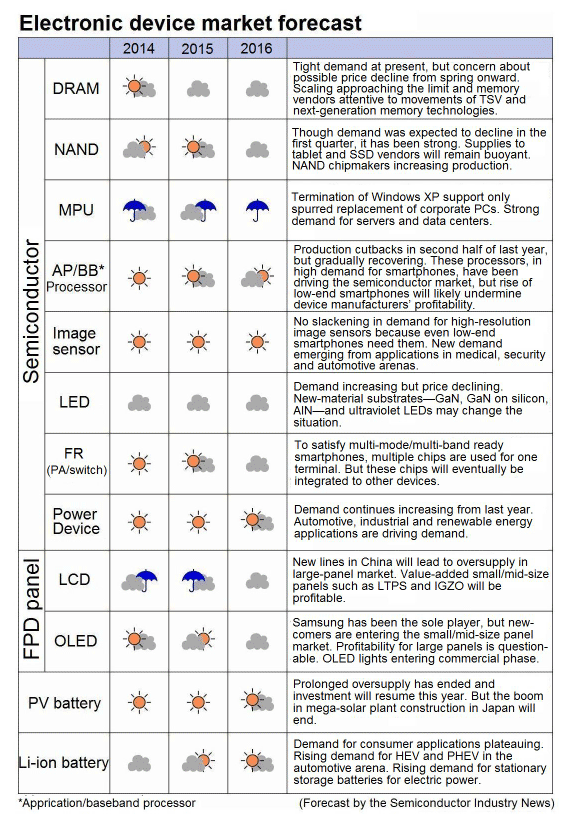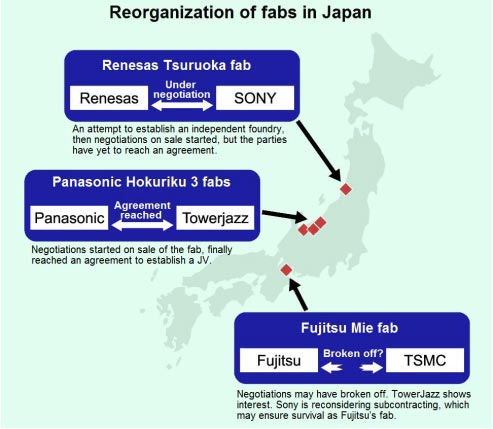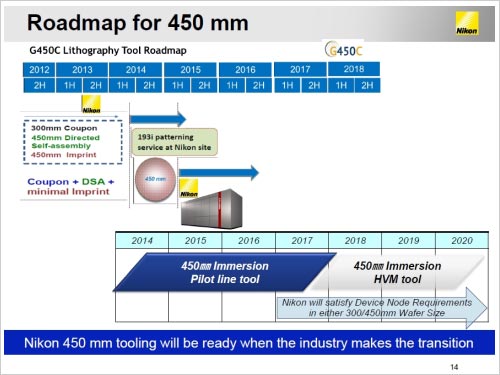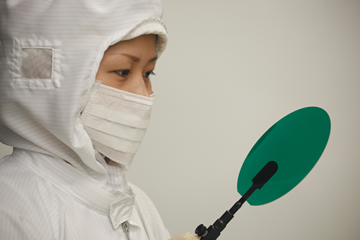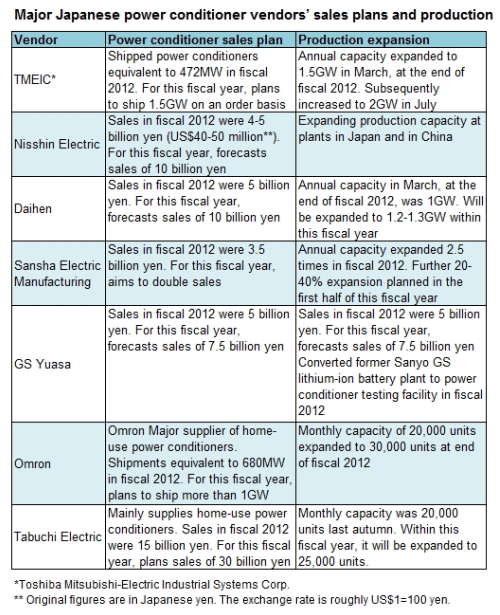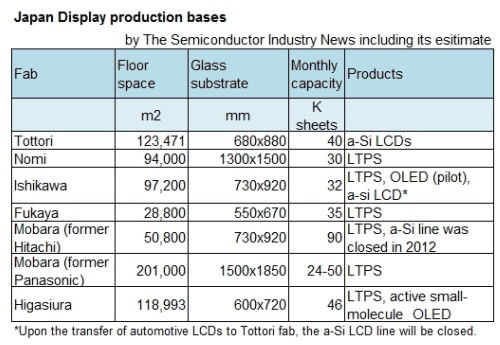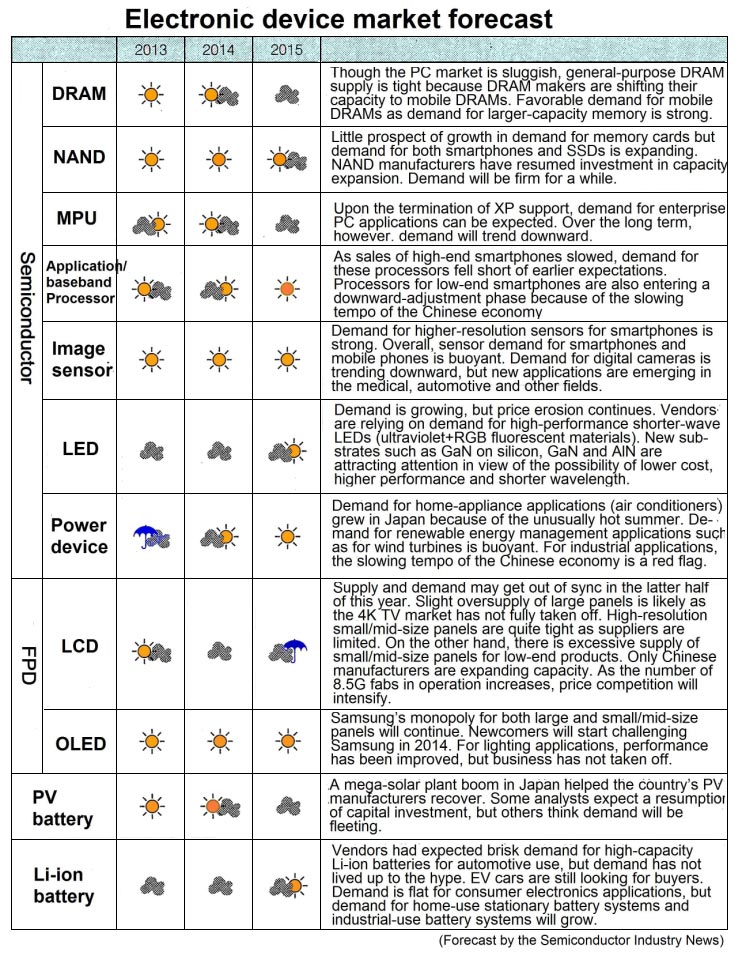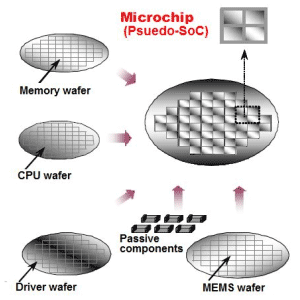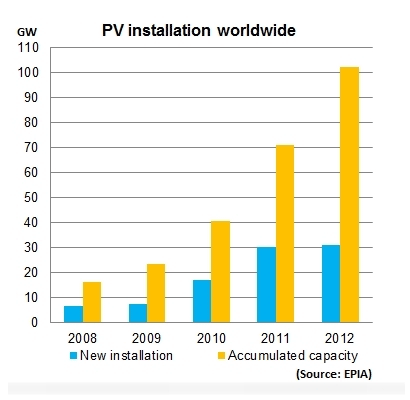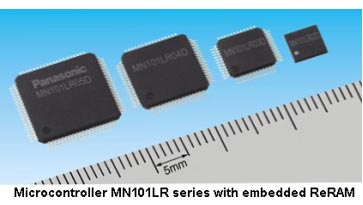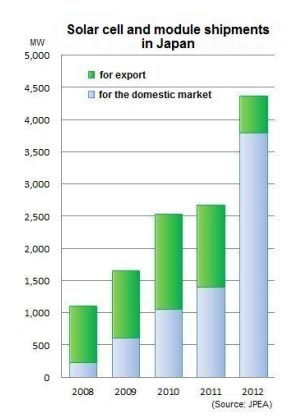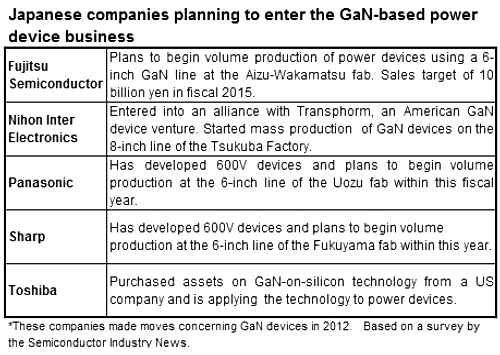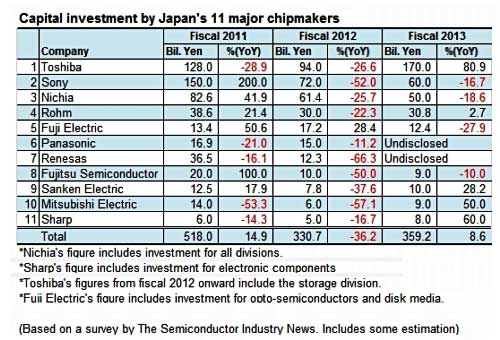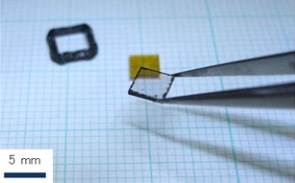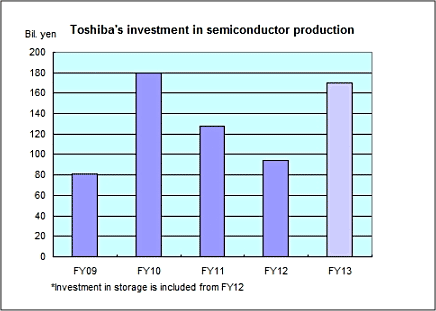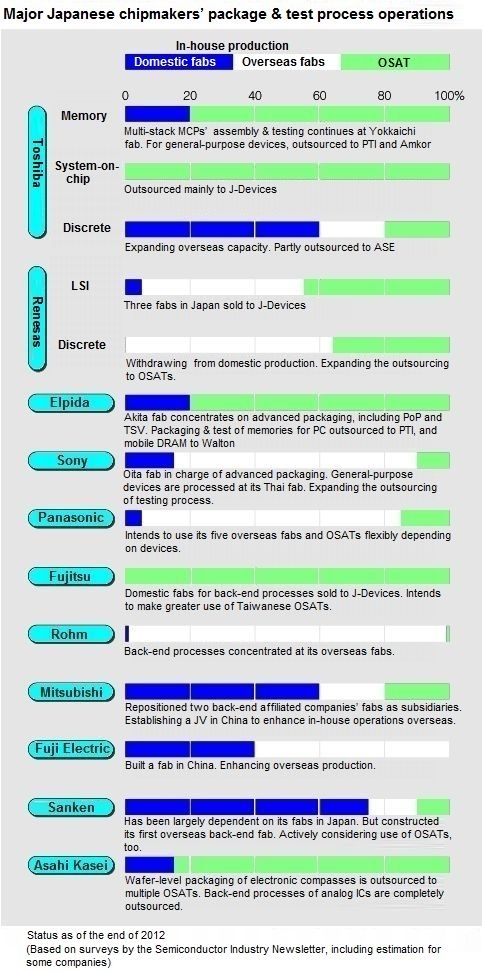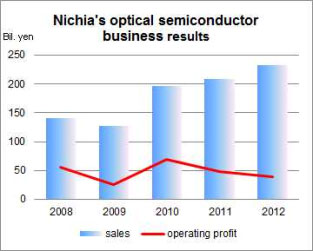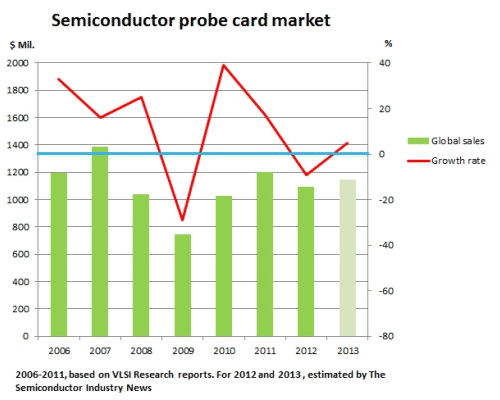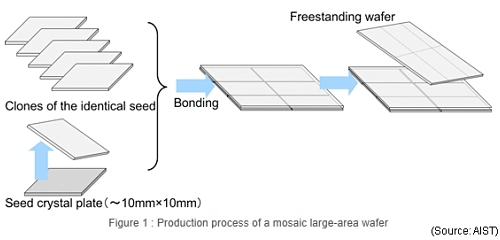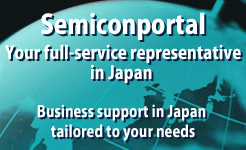The Semiconductor Industry News
"The IT industry is inexorably approaching maturity. Sure, the recent surge in orders for semiconductor production equipment may lead people to imagine that the go-go times are about to return. But unless the electronic device industry finds new growth vectors, the future won't be bright," said Akira Minamikawa, one of Japan's most respected semiconductor industry analysts.
[... more]
Demand for smartphones and other mobile gizmos is booming and motor vehicles are packed with more and more electronic gear. With these two big applications to the fore, robust growth of the semiconductor and display markets is in prospect for 2014 and 2015.
[... more]
Rohm Co., Ltd. has started a foundry service for fabricating microelectromechanical systems (MEMS) integrating thin-film piezoelectric element technology, which the company claims is the first such foundry service in the world.
[... more]
"The worldwide PV installation boom has subsided, with one big exception—Japan. More than 2,000 megasolar installations are planned in this country," the bullish editor-in-chief of an industry magazine said to me the other day. He contended, "Japan is at the epicenter of what promises be a new boom in PV installations."
[... more]
Innovation Network Corporation of Japan (INCJ), a government-backed investment fund, together with Japan Display Inc., Sony Corp., and Panasonic Corp., will launch a new company, JOLED Inc., in January next year, integrating the R&D functions of Sony and Panasonic for organic light-emitting diode (OLED) display panels. Through this collaboration, the companies aim to accelerate development and expedite commercialization of OLED display panels.
[... more]
The Global Integration Initiative (GINTI), a center equipped with facilities and an environment for R&D, prototyping and pilot production of 3D stacked LSIs, started a full-service operation in Miyagi Prefecture in April.
[... more]
The hydrogen energy era is on the way. Toyota has announced it may commercialize hydrogen-powered fuel cell vehicles (FCVs) next year and has set itself the target of cutting the cost per vehicle to 5 million yen (US$50,000*)—one-twentieth of the current cost. Likewise, Honda plans to introduce FCVs next year. Nissan is targeting introduction in 2017, slightly behind its competitors.
[... more]
The Ministry of Economy, Trade and Industry (METI) predicted last February that the global market for 3D printers and materials will reach 1 trillion yen (US$10 billion*) in 2020, roughly quadrupling from 230 billion yen in 2012.
[... more]
Japanese chipmakers have been manufacturing some products for more than two decades. This prompted an executive of Massachusetts-based aftermarket manufacturer Rochester Electronics to comment that the Japanese semiconductor industry seems to have no policies on discontinuing production of obsolete devices. Though his comment contains more than a grain of truth, Japan's chipmakers are reviewing their business practices and have started winnowing their product portfolios.
[... more]
"What happened? I've never seen such a rush of orders. As semiconductor investment has been in low gear, we can't replenish production facilities and manpower immediately. We are naturally delighted about the tremendous amount of orders, but the deadlines keep us awake at night," said a gleeful executive of a Japanese manufacturer of wafer fab equipment.
[... more]
Electronic components have grown in importance to the point that they are the face of Japan's electronics industry. With input from Yuzuru Sato, an analyst with Tokyo-based DG Research, who tracks the industry, we identify what is hot and how this fiscal year is shaping up.
[... more]
Toyota Motor Corp. has made clear it intends to use SiC power devices, currently under development in house, in mass-produced cars by around 2020. The company plans to begin test runs of cars equipped with the devices on public roads within a year.
[... more]
I relished a recent opportunity to listen to G. Dan Hutcheson, CEO and chairman of VLSI Research Inc., share his insights, especially as I hadn't heard his take on the semiconductor industry for quite a while. Not only is Dan Hutcheson an acknowledged authority on the industry, he is also one of its most distinctive voices. In particular, his analyses of production equipment and process technologies tend to outshine the observations of other commentators.
[... more]
Toshiba Corp., with partner SanDisk, will build a fab dedicated to 3D NAND process at its Yokkaichi Operations in Japan. The fab is slated for completion in summer 2015 and production is scheduled to begin in the second half of fiscal 2015. Investment in the project is expected to reach 500 billion yen (US$5 billion*).
[... more]
On April 8, Sony Corp. opened Yamagata Technology Center, formerly Renesas' 300mm Tsuruoka fab, and disclosed a plan to establish monthly production capacity of 20,000 300mm wafers for CMOS sensors by March 2016. The project will involve investing about 28 billion yen (US$280 million*) to refurbish existing equipment and install new equipment.
[... more]
The worldwide flat display market is forecast to be worth 162 billion dollars in 2014, about half the value of the semiconductor market. But average annual growth in the decade from 2010 to 2020 is expected to be 7.4%, leisurely compared with the explosive growth in the past, and slowing with every passing year.
[... more]
The outlook for next-generation lithography, the key technology in the semiconductor industry, is in flux. The latest snapshot reveals that EUV lithography is no longer necessarily in pole position, while ArF immersion technology with multi-patterning has emerged as the most practical solution for 10nm and maybe even 7nm.
[... more]
I was born and bred in Yokohama, where my family has been running a busy restaurant specializing in delicious soba noodles, a Japanese favorite, for more than 130 years. Looking back to my childhood, I have vivid memories of workers from factories across the Keihin Industrial Zone* dropping into our shop to eat, drink, talk about everything under the sun and generally have a good time.
[... more]
Semiconductor production equipment manufacturers' expectations of the post-sales business, including refurbishing used equipment and after-sales services, are on the rise as they endeavor to turn it into a major revenue stream. This is certainly true of Canon, whose imminent acquisition of Austin, Texas-based Molecular Imprints Inc., a nanoimprint system manufacturer, indicates its aggressive plans concerning leading-edge lithography systems.
[... more]
Mitsubishi Electric Corp. launched its new Power Device Innovation Center earlier this month to concentrate development, design and sales of power devices at its Power Device Works in Kitakyushu, Fukuoka prefecture. Thus, sales, design and development operations for power devices are now integrated under one roof alongside the company's manufacturing plant for these products. The center represents investment totaling 2.5 billion yen (US$25 million).
[... more]
The restructuring of Japan's PCB sector has accelerated, reflecting the rapid contraction of domestic business as customers shift operations overseas and adopt new manufacturing processes.
[... more]
"I hear that Mitsubishi Heavy Industries is building a national regional jet and Honda* is building a small business jet with their own technologies. But I am wondering why Japanese manufacturers can't make top-of-the-line fighters and big airliners, which will bring bigger business."
[... more]
Semiconductor production equipment manufacturers' expectations of the post-sales business, including refurbishing used equipment and after-services, are on the rise as they endeavor to develop it into a major revenue stream. This is certainly true of Tokyo Electron, which is setting up a dedicated organization to aggressively promote its post-sales business.
[... more]
To promote commercialization and take-up of solid hydrogen-source fuel cells, the Kyoto Fuel Cell Alliance* was launched by Rohm, Kyoto University, Aquafairy and others in January. The alliance's mission is to promote commercialization of the fuel cell system, develop applications, establish an international standard for the system, and secure intellectual property. The alliance includes organizations from industry, academia and government. The kickoff meeting was held on January 9 in Kyoto.
[... more]
Capital investment by the global semiconductor industry is estimated at 5 trillion yen (US$50 billion*) for 2013, roughly the same as for the previous year. As you may know, the value of the global semiconductor market edged up to 30 trillion yen from the previous year, as if to rub in the fact that the days when the market grew by leaps and bounds are long gone.
[... more]
Electronic design automation (EDA) is indispensable for developing, designing, and manufacturing electronic products. In the CAD/CAM system arena, when it comes to EDA for PCB design, Zuken Corp. retains its lead in Japan and the second position in the global market.
[... more]
Sluggish demand for the general run of electronic devices—including semiconductors, displays, and so forth, as well as for batteries, is in prospect as leading smartphone vendors curb first-quarter production. In presenting its market forecast, The Semiconductor Industry News cautions that spring may be cancelled or at least be disappointing this year. The climate remains good but bad weather is likely, so hang on to your umbrella.
[... more]
Of three major negotiations on the change of ownership of wafer fabs in Japan, one, between Panasonic and TowerJazz, recently resulted in a deal. But as for the other two, the parties have yet to reach agreement and the final outcomes remain difficult to predict.
[... more]
Sumitomo Electric Industries, Ltd. is boosting its GaN wafer business to compensate for slack demand for GaAs wafers, the principal products of its compound semiconductor wafer business that appears to have hit a wall recently.
[... more]
Panasonic Corp. is in a flurry of activity as it explores various ways of restructuring its semiconductor business. Media reported that Panasonic would spin out three fabs into a separate company in which TowerJazz of Israel had essentially agreed to take a 50% equity stake, but the situation remains in flux.
[... more]
It was standing room only at the 450mm Executive Forum, one of the high-profile seminars at Semicon Japan 2013 held earlier this month near Tokyo, as the people in the hot seats at G450C, imec, Nikon and Tokyo Electron explained their organizations' progress in transitioning to 450mm.
[... more]
The crossover of the ICT/semiconductor field and the medical equipment sector has emerged as a prominent theme. The medical equipment industry is on a steady, long-term, growth trajectory, whereas the electronic device industry, a plaything of fluctuating demand, is a veritable roller coaster in comparison. The dependable, expanding world of medical equipment is an inviting prospect for companies in the electronics industry.
[... more]
The first crop of advanced driver assistance systems (ADASs) have already started attracting consumers. For example, cars of Fuji Heavy Industries' Subaru automotive unit equipped with Subaru EyeSight, a collision avoidance system, have generated plenty of interest and are selling well in Japan. More than 150,000 vehicles with EyeSight have already been sold in Japan, according to Fuji Heavy Industries.
[... more]
Panasonic Corp. and Tesla Motors have reached an agreement whereby Panasonic will increase its supply of automotive-grade lithium-ion battery cells to Tesla. Under this agreement updating and expanding the companies' 2011 arrangement, Panasonic is to supply almost 2 billion cells over the four years from 2014 to 2017.
[... more]
Showa Denko (SDK) announced that it has established volume production technology for 6-inch silicon carbide (SiC) epitaxial wafers, the industry’s largest such wafer, and started sales last month.
[... more]
Although Japan's semiconductor industry is no longer No. 1 in the global market, it still retains the second position with a respectable 16% share. But the US is way out in front while Korea and Taiwan are snapping at Japan's heels.
[... more]
Ever since Japan introduced a feed-in-tariff system in July 2012, the country's PV panel market has been on a roll and power conditioners, which are indispensable components for PV systems, are also benefiting. With demand for power conditioners in Japan growing at an annual rate of more than 50%, vendors are boosting production capacity.
[... more]
Japan Display Inc. will increase the capacity of its 6G fab in Mobara, which started operation in June, 50% by the end of this year and will double it by around next June.
[... more]
Toshiba Hokuto Electronics Corp. has developed mass-production technology for pseudo-SoC, which enables high-density high-functionality modules integrating various devices such as LSIs, analog ICs and passive components, and will begin production in October. The pseudo-SoC technology* is positioned between system-in-package (SiP) and system-on-chip (SoC) technologies.
[... more]
"Tokyo Electron was once the world's leading supplier of semiconductor production equipment. How could such a company fall into the hands of its biggest American rival! It's a national disgrace! Tokyo Electron should have toughed it out alone as a champion of Japanese industry," exclaimed an exasperated retired executive of a major Japanese chipmaker.
[... more]
Toshiba Hokuto Electronics Corp. has developed mass-production technology for pseudo-SoC, which enables high-density high-functionality modules integrating various devices such as LSIs, analog ICs and passive components, and will begin production in October. The pseudo-SoC technology* is positioned between system-in-package (SiP) and system-on-chip (SoC) technologies.
[... more]
Billed as a tonic for the Japanese economy, Abenomics certainly seems to be good for the country's automakers, judging by the way they are expanding capital investment. Toyota, the biggest contender in Japan's automotive domain, plans to invest 920 billion yen (US$9.2 billion**) this fiscal year, Nissan has earmarked 570 billion yen, and Honda intends to spend 700 billion yen. Compared to these sums, Panasonic, one of the leaders of Japan's electronics industry, plans a modest 205 billion yen in capital investment for this fiscal year, 34% less than last year. Major players in Japan's automotive industry are far more bullish, planning to expand capital investment 20% and R&D budgets 25% on average.
[... more]
From the mid-2000s through the end of the decade, new installations of PV power generation facilities grew rapidly in Europe, given a helping hand by the incentive schemes of several European countries, but growth sputtered in 2012. While the European PV market, which had led the global PV market for years, is shrinking, the center of gravity has shifted to Asia where China and Japan have emerged as high-growth markets. Nevertheless, slowing global demand for PV systems is stoking competition, leading to a shakeout among Chinese manufacturers whose low prices have enabled them to capture market share.
[... more]
Panasonic Corp. will take the lead in volume production of resistive random-access memory (ReRAM), which will be embedded in its MN101LR series of 8-bit microcontrollers in place of flash memory. Targeting applications that require low-power operation such as sensors, security systems and portable healthcare devices, production will begin within this month with a startup capacity of 1 million units a month.
[... more]
Lenovo and Sharp have jointly developed smart TVs that connect to the Internet and can deliver streaming content.
[... more]
Under a blazing sun, I am walking the streets of Kurume, a city in northern Kyushu. Traditionally famous for cotton fabrics known as Kurume kasuri, contemporary Kurume is well connected with the rest of Japan as the Kyushu Shinkansen stops here. In front of the station, my eyes are drawn to a bizarre monument in the form of a gigantic tire. It was erected by tire maker Bridgestone, founded in Kurume in 1931*. And here is the karakuri (automaton) clock monument honoring Kurume's native son, Hisashige Tanaka, founder of Toshiba. Wiping the sweat from my brow as I pass these monuments, I recall that Kurume is also the hometown of Seiko Matsuda, Japan's eternal pop idol.
[... more]
Japan's solar cell and module market on a shipment basis in fiscal 2012 ended in March amounted to 4,371 MW, up 60% over the previous year, almost tripling in size, while exports plummeted about 60%, according to the Japan Photovoltaic Energy Association.
[... more]
For next-generation power devices, the number of Japanese chipmakers betting on GaN-based devices is increasing. In terms of next-generation power device candidates, it is a two-horse race: until recently it was widely accepted that SiC was right for high-voltage applications whereas GaN would be suitable for low-voltage ones. But recent moves by manufacturers suggest that GaN may dominate the entire field.
[... more]
The shale gas revolution is a game-changer with profound implications for the global economy, politics and society. The sudden advent of shale gas as the next-generation fuel of choice has already drastically lowered the cost of energy to around 6 yen (6 US cents*) per kW/h. So stop worrying about running out of fossil fuels. Instead, welcome shale gas—the hero of a brave new world awash with energy. By some estimates, our planet has enough shale gas and conventional natural gas for the next 400 years at current rates of consumption. Moreover, not only is shale gas not burdened by the risks associated with nuclear power plants, but CO2 emissions are much lower than for other fossil fuels.
[... more]
The Semiconductor Industry News has found that capital investment by Japan's 11 major chipmakers will amount to 390 billion yen (US$3.9 billion*) for fiscal 2013, an increase of about 20% from the previous year, assuming the two companies that did not disclose their plans would invest the same amounts as last year.
[... more]
A research group of the National Institute for Materials Science (NIMS) has developed a diamond synthesis technique based on chemical vapor deposition (CVD), which dramatically increases the source material utilization rate to as high as 80%. The technique is expected to lower the production cost of high-purity diamond bulk crystal, which cannot be synthesized by the conventional method at low cost.
[... more]
Towering head and shoulders about the rest of the players, TMSC is the world's preeminent semiconductor foundry, basking in the prosperity that comes with commanding an overwhelming share of the planet's foundry market. Meanwhile, the chip industry is clearly advancing into a fabless or fab-lite future, a megatrend that works to TSMC's advantage.
[... more]
Toshiba Corp. plans to execute capital investment of around 170 billion yen (US$1.7 billion*) in its Semiconductor and Storage Company this fiscal year, 80% more than it invested in that business last year, to advance NAND scaling to the 1Ynm** process and to double capacity of the Y5 fab at the Yokkaichi plant, Mie Prefecture, by completing the second phase of construction.
[... more]
Tokyo Electron (TEL) plans to complete the development of ink-jet OLED production equipment for 8G glass substrates by the end of this year, with a view to meeting anticipated demand as the OLED TV market is expected to take off around 2015.
[... more]
In-house back-end process operations in Japan are shrinking fast as Japanese chipmakers shift operations overseas and increasingly rely on outsource assembly & test (OSAT) service providers. But chipmakers attach a high value to back-end processes for power devices, such as IGBTs, and are enhancing in-house production capacity for power modules.
[... more]
"The Abe administration will be desperately pursuing policies to unleash economic growth in the run-up to the Upper House election this summer. The government is already active—for example, beating the drum for Japanese innovation, promoting the advance of Japan's medical equipment industry into the global marketplace, and encouraging Japanese women to participate fully in the world of work. If the upward trend continues, the Nikkei index may well reach the 18,000-yen level and the yen could drop as low as 120 to the dollar!"
[... more]
Nichia Corp. plans to invest 50 billion yen (US$526 million*) this fiscal year**, mainly for LED capacity expansion to keep its edge in the global market.
[... more]
The DRAM market is pumped up again thanks to brisk demand for the memories that go into smartphones and tablets. This is all the more welcome because a stagnant world economy put a brake on capital investment in the DRAM sector last year, playing havoc with the businesses of manufacturers of semiconductor equipment and materials. Recently, with demand for smartphones and tablets on a roll, DRAM makers are convinced that the market has changed for the better.
[... more]
The worldwide semiconductor probe card market was worth 1.1 billion dollars in 2012, having shrunk 9% compared with the figure for 2011, but will recover 5% to reach 1.15 billion dollars this year, according to The Semiconductor Industry News.
[... more]
EDP Corp., a venture company in Osaka specializing in single-crystal diamond substrates, has started offering a 1-inch square diamond substrate for device fabrication and plans to commercialize larger 2-inch wafers by 2015.
[... more]
Blog: Sensor technology the new frontier: says keynote speaker at Silicon Sea Belt Summit in Fukuoka
"Which new technology is going to create the next big new market, pushing back the frontier and opening up new territory? We have seen the IT industry's growth rate slow to a crawl, virtually leveling off. The history of our industry shows that unless something capable of leading us into a new era emerges, growth comes to a standstill," said Chong-Min Kyung, director of the Korea Advanced Institute of Science and Technology (KAIST), in a keynote speech at Silicon Sea Belt Summit 2013 in Fukuoka last month.
[... more]
Toshiba Corp. thinks its semiconductor business results for the fourth quarter (January-March) will likely be below the level of those for the third quarter (October-December), as orders from major customers have decreased. The cutback in NAND production in the fourth quarter will exceed the 10% cutback that Toshiba made in the third quarter.
[... more]
The woes of the Boeing 787 have had repercussions worldwide, not least in Japan. The scale of the business at stake is massive: as much as $160 billion if, as planned, Boeing manages to build 800 jetliners at about $200 million a pop. But this high-flying business plan is threatened by safety concerns that could ground the Boeing 787. This would deal a heavy blow to the Japanese manufacturers supplying state-of-the-art components and materials, such as carbon fiber and lithium-ion batteries, to Boeing.
[... more]
While curbing capital investment is the norm among Japan's semiconductor manufacturers, Hamamatsu Photonics K.K. is bucking the trend by earmarking 13.5 billion yen (US$159 million*) for investment in new production capacity this fiscal year**, up 56% from the previous year. The company plans to invest 38.5 billion yen over the next three years, including this fiscal year's 13.5 billion yen.
[... more]
Warning: Invalid argument supplied for foreach() in /home2/semicon/hosting/spiwww/include/Banner.php on line 78
Warning: array_multisort(): Argument #1 is expected to be an array or a sort flag in /home2/semicon/hosting/spiwww/include/Banner.php on line 81
Warning: Invalid argument supplied for foreach() in /home2/semicon/hosting/spiwww/include/Banner.php on line 85


